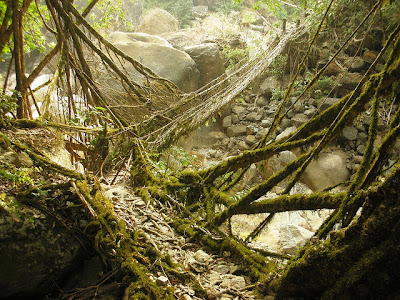Mawsynram is reportedly wettest place on earth, with the highest average annual rainfall. Listed in Guinness book of world records, as per Guinness book rainfall recorded 26,000 millimeters of rainfall in 1985 and it is reported the wettest place on earth.
This wettest place located at 16KM from west of cherrapunjee, on Khasi Hills in Meghalaya, India. The word Maw, meaning stone and thus might refer to certain megaliths in surroundings. These Hills are rich with such megaliths - Khasi monoliths erected fairly recently to commemorate important events and people.
This place features a subtropical highland climate with an extraordinarily rainy and lengthy monsoonal season, when checked with Koppen climate classification. And this place 12 m of rain in an average year, and a majority of it falls during the monsoon months.
 |
| Sunset View point in Mawsynram |
Three reasons can be cited for high rainfall at Mawsynram:
1. The warm moist winds of the northward-moving air from the Bay of Bengal during the monsoon, which cover an extensive area but are forced to converge into the narrower zone over the Khasi Hills, thus concentrating their moisture.
2. The alignment of the Khasi Hills (east to west) places them directly in the path of the airflow from the Bay of Bengal, producing a significant uplift (plus cooling, further condensation and thus more rain).
3. Finally, uplift over the Khasi Hills is virtually continuous in the monsoon period because the lifted air is
constantly being pulled up by vigorous winds in the upper atmosphere; hence the rainfall is more or less continuous.
Mawsynram, one of the well known spots of Meghalaya, and is frequented by nature lovers enjoying a walk by its steep and down sliding slopes, breathing in the fresh air, experience the clear blue sky, the wind that brushes their face, catching glimpses of the mountain birds and the nearly deafening sound of the roaring waterfalls. The orchids that bloom on the low lands, the thrilling adventure in the unexplored caves that are pathways to many rivers are experiences that remain forever acting as a balm for the city bred travelers looking for solace in nature’s soothing memories.

Yet another attraction near this wettest place is a cave called the Mawjymbuin Cave which is one of the well known caves in Meghalaya. This cave, due to years of weathering and due to dripping of mineralized solutions and deposition of calcium carbonate, it has thus given rise to some magnificent stalagmites. An extraordinary rock formed by geological means called Symper Rock is located close to the Weiloi Village, at a distance of one and half kilometers from the Ranikor-Balat -Mawsynram-Shillong Highway. This place is famous for the gigantic formation of stalagmite, which resembles the shape of a 'Shivalinga'. This formation is housed in a cave, whose local name is Mawjymbuin.






















